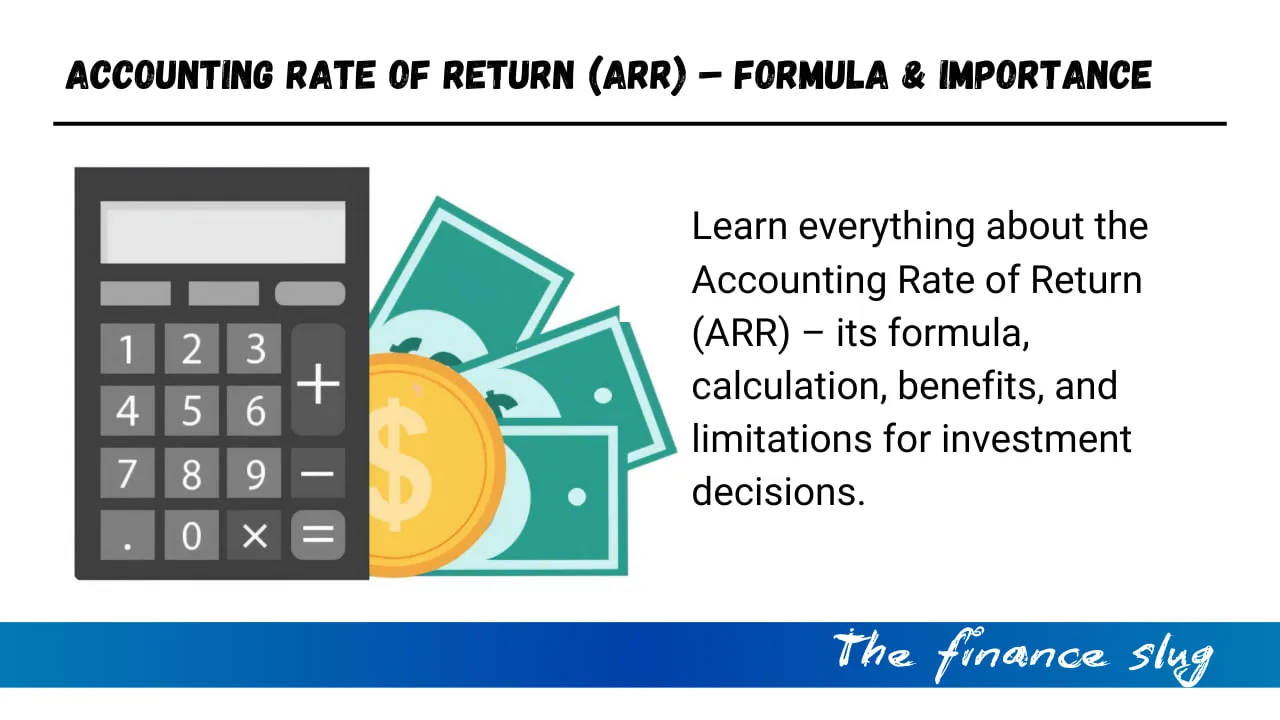
Introduction
When making investment decisions, businesses rely on financial metrics to determine potential profitability. One such metric is the Accounting Rate of Return (ARR). ARR helps investors evaluate whether a project is worth pursuing by comparing its expected earnings with the initial investment cost.
In this blog, we will explore the ARR formula, calculation steps, advantages, limitations, and its relevance in financial decision-making.
What is Accounting Rate of Return (ARR)?
The Accounting Rate of Return (ARR) is a financial metric that measures the expected return on an investment based on accounting profits rather than cash flows. Unlike other investment evaluation methods like Net Present Value (NPV) or Internal Rate of Return (IRR), ARR focuses on book values and does not consider the time value of money.
ARR is commonly used by businesses to compare different projects and determine which offers the highest return relative to the initial investment.
Formula for Accounting Rate of Return (ARR)
ARR=(Average Annual Accounting Profit/Initial Investment Cost)×100
Where:
- Average Annual Accounting Profit = Total Expected Accounting Profit / Number of Years
- Initial Investment Cost = The total capital required to start the project
This formula expresses ARR as a percentage, making it easy to compare with other investments.
How to Calculate ARR – Step-by-Step Guide
To understand how ARR works, let’s go through a step-by-step example.
Example:
A company is considering an investment of $100,000 in a new machine. The machine is expected to generate annual profits of $20,000 for 5 years. The total expected profit over 5 years is $100,000.
Step 1: Calculate the Average Annual Accounting Profit
Average Annual Accounting Profit=Total Expected Profit/Number of Years=100,000/5=20,000
Step 2: Apply the ARR Formula
ARR=(20,000/100,000)×100=20%
Thus, the Accounting Rate of Return (ARR) is 20%.
Advantages of ARR
- Simplicity & Ease of Calculation
- ARR is easy to compute and understand, making it accessible to managers and investors without advanced financial knowledge.
- Useful for Comparing Investment Projects
- Since ARR provides a percentage return, it allows businesses to compare multiple investment opportunities.
- Focuses on Accounting Profitability
- Unlike cash flow-based methods, ARR considers net income, aligning with financial reporting and business accounting.
- No Need for Complex Discounting Methods
- Unlike NPV and IRR, ARR does not require discounting future cash flows, simplifying decision-making.
Limitations of ARR
- Ignores Time Value of Money (TVM)
- ARR does not consider that money today is worth more than the same amount in the future, leading to potential inaccuracies.
- Based on Accounting Profit, Not Cash Flow
- Since ARR relies on accounting profits rather than cash inflows, it may not reflect actual financial viability.
- Does Not Account for Risk
- ARR does not adjust for risk factors that could impact future earnings, making it less reliable for uncertain projects.
- No Consideration for Project Duration
- A project with a shorter lifespan but a high ARR might seem more attractive than a longer-term, stable investment.
Also Read : What Is Accounting Profit? Definition, Formula & Importance
ARR vs. Other Investment Appraisal Methods
| Investment Metric | Definition | Considers Time Value of Money? | Focus |
|---|---|---|---|
| ARR | Measures return based on accounting profits | ❌ No | Accounting profits |
| NPV (Net Present Value) | Measures profitability using discounted cash flows | ✅ Yes | Cash flows & profitability |
| IRR (Internal Rate of Return) | Calculates the discount rate where NPV = 0 | ✅ Yes | Cash flows & rate of return |
| Payback Period | Time taken to recover the investment cost | ❌ No | Investment recovery speed |
From this comparison, it’s clear that while ARR is useful, it is less comprehensive than NPV and IRR for investment decisions.
When Should You Use ARR?
ARR is best used in the following scenarios:
- Preliminary investment screening: Quick evaluation before using more detailed financial analysis.
- Projects with stable profits: When accounting profits remain steady over time.
- When cash flow details are unavailable: ARR works when businesses do not have detailed cash flow projections.
However, for high-risk investments or those requiring long-term analysis, methods like NPV and IRR are preferable.
Final Thoughts
The Accounting Rate of Return (ARR) is a simple yet effective tool for assessing investment profitability based on accounting profits. While it is useful for initial screening, it has limitations such as ignoring the time value of money and cash flows.
For well-rounded investment decisions, ARR should be used alongside NPV, IRR, and other financial metrics. Understanding ARR’s strengths and weaknesses can help businesses make more informed financial choices.
Also Read : What Are Accounting Principles? A Comprehensive Guide
Frequently Asked Questions (FAQs)
1. What is a good ARR percentage?
A good ARR varies by industry, but generally, a higher percentage indicates a more profitable investment. Companies often compare ARR to their required rate of return or industry benchmarks.
2. How is ARR different from ROI?
ARR focuses on accounting profits, while Return on Investment (ROI) considers total profits, including cash flows. ROI also typically accounts for the time value of money.
3. Can ARR be negative?
Yes, ARR can be negative if the project generates losses instead of profits. A negative ARR suggests the investment is not financially viable.
4. Why do businesses still use ARR despite its limitations?
ARR is simple to calculate and does not require detailed cash flow projections, making it useful for quick comparisons and preliminary investment screening.
5. How does depreciation affect ARR?
Depreciation reduces accounting profits, lowering the ARR percentage. Different depreciation methods can impact ARR calculations significantly.
Stock Market Crash Today: A Bloodbath on Monday – What You Need to Know
Published on financeslug.xyz The global financial markets are reeling from a massive sell-off, and Indian…
Wall Street Bonuses Reach Record $47.5 Billion in 2024, Up 34% from Previous Year
How to Convert Delimited CSV Data into Columns in Excel
CSV (Comma-Separated Values) files are widely used for data exchange, but when opened in Excel,…
Harvard University Announces Free Tuition for Families Earning $200K or Less
Harvard’s New Tuition-Free Policy: What You Need to Know Harvard University has unveiled a groundbreaking…
Eli Lilly’s 1.8B Dollar Investment in Weight Loss Drugs
Ireland’s Weight-Loss Drug Boom: A Game-Changer for Economy and Healthcare Ireland is witnessing a surge…
Forever 21 Files for Bankruptcy Again: The End of an Era in Fast Fashion?
Forever 21, once a staple in American malls and a leader in the fast-fashion industry,…







